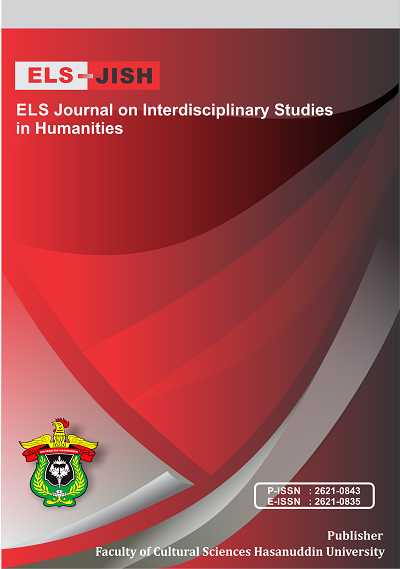Differences in the Level of Tiktok Addiction Between Males and Females Student in Secondary Education in Menganti Sub-District Gresik District
DOI:
https://doi.org/10.34050/elsjish.v5i3.22574Keywords:
Addiction, Student, Social Media, TiktokAbstract
Tiktok is one of the most popular short video platforms today and many active users spend a lot of time watching Tiktok. This condition makes the phenomenon of Tiktok addiction widespread. So this article aims to investigate the level of Tiktok addiction based on male and female gender in junior high school students in Menganti Sub-District, Gresik District. This research approach is descriptive comparative. The population of this study includes all eighth grade students in Menganti, Gresik. While the sample is 344 grade VIII students in Menganti, Gresik, in detail there are 179 male students and 165 female students. The sample selection technique used random sampling at 4 schools, namely SMP Negeri 18 Gresik, SMP Negeri 29 Gresik, SMP NU Bahrul Ulum, and SMP Sunan Giri Menganti. Data collection techniques used closed questionnaires and documentation. The instrument used is a Tiktok Addiction Scale questionnaire and a matched list. The data were analyzed using the Mann Whitney non-parametric technique using SPSS. The findings of the study showed that there were differences in the level of addiction in male and female students in grade VIII in Menganti, Gresik. Tiktok addiction in male students is in the low category, while the level of Tiktok addiction for female students is in the medium category.
References
Aheniwati, A. (2019). Pengaruh Internet Bagi Anak. Edukasia: Jurnal Pendidikan, 6(2).
Arsriani, I. A. I., & Darma, G. S. (2013). Peran Media Sosial Online Dan Komunitas Terhadap Keputusan Nasabah Bank. Jurnal Manajemen Bisnis, 10(2), 48–68.
Ayar, D., Bektas, M., Bektas, I., Akdeniz Kudubes, A., Selekoglu Ok, Y., Sal Altan, S., & Celik, I. (2017). The effect of adolescents’ internet addiction on smartphone addiction. Journal of Addictions Nursing, 28(4), 210–214. https://doi.org/10.1097/JAN.0000000000000196.
Cahyono, A. S. (2016). Pengaruh media sosial terhadap perubahan sosial masyarakat di Indonesia. Jurnal Publiciana, 9(1), 140–157.
Chen, J. S. (2021). TikTok Addiction Scale: Reliability and Validity. https://doi.org/10.17605/OSF.IO/YQU4R
Damayanti, N. C., Supriyanto, A., & Hartini, S. (2021). Analisis Konseptual: Peran Konseling Kedamaian Strategi untuk Mereduksi Kecanduan Media Sosial Aplikasi Tik Tok. In Seminar Nasional “Bimbingan dan Konseling Islami” (hal. 1201–1212).
Damayanti, T., & Gemiharto, I. (2019). Kajian Dampak Negatif Aplikasi Berbagi Video Bagi Siswa di Bawah Umur di Indonesia. Communication, 10(1), 1–15. https://doi.org/http://dx.doi.org/10.36080/comm.v10i1.809
Farikhah, S. (2018). Pendidikan anak dalam perspektif gender: Kajian konseptual dan strategi aksi. x.
Hayes, C., Stott, K., Lamb, K. J., & Hurst, G. A. (2020). Making Every Second Count: Utilizing TikTok and systems thinking to facilitate scientific public engagement and contextualization of chemistry at home. Journal of Chemical Education, 97(10), 3858–3866. https://doi.org/https://doi.org/10.1021/acs.jchemed.0c00511
Hidajat, M., Adam, A. R., Danaparamita, M., & Suhendrik, S. (2015). Dampak Media Sosial dalam Cyber Bullying. ComTech: Computer, Mathematics and Engineering Applications, 6(1), 72–81. https://doi.org/https://doi.org/10.21512/comtech.v6i1.2289
Iqbal, M. (2020). TikTok revenue and usage statistics. In Business of Apps.
Jani, S., & Weismann, I. T. J. (2021). Pengaruh Kecanduan Media Sosial Terhadap Prestasi Belajar Mahasiswi Asrama Di Sekolah Tinggi Filsafat Jaffray Makassar. Repository Skripsi Online, 3(1), 158–165.
Kaye, D. B. V., Chen, X., & Zeng, J. (2020). The co-evolution of two Chinese mobile short video apps: Parallel platformization of Douyin and TikTok. Mobile Media & Communication. https://doi.org/205015792095212
Kemp, S. (2020). Digital 2020: Indonesia. Indonesia. Diambil dari https://datareportal.com/reports/digital-2020-indonesia
Kemp, S. (2021). Digital 2021. Indonesia.
Kemp, Simon. (2022). Digital 2022: Indonesia. Indonesia. Diambil dari https://datareportal.com/reports/digital-2022-indonesia
Omar, B., & Dequan, W. (2020). Watch, share or create: The influence of personality traits and user motivation on TikTok mobile video usage. International Journal of Interactive Mobile Technologies, 14(4), 121–137. Diambil dari https://doi.org/10.3991/IJIM.V14I04.12429
Pertiwi, T. W. (2022). Pendekatan Client Centered Counseling Dalam Mengatasi Kecanduan TikTok Pada Remaja Awal (Studi pada remaja di Desa Munjul, Kec. Munjul, Kab. Pandeglang, Banten). UIN SMH BANTEN.
Sahin, C. (2018). Social Media Addiction Scale-Student Form: The Reliability and Validity Study. Turkish Online Journal of Educational Technology-TOJET, 17(1), 169–182.
Salsabila, E. F., Hanggara, G. S., & Ariyanto, R. D. (2021). Pengaruh Media Sosial Tiktok Terhadap Perilaku Sopan Santun Siswa SMK PGRI 2 Kediri. In Prosiding Konseling Kearifan Nusantara (KKN) (hal. 32–41).
Sari, D., Madyan, M., & Mahendra, A. (2021). Penggunaan Aplikasi Tik Tok Sebagai Ajang Eksistensi Diri (Fenomenologi Penggunaan Tik Tok Pada Mahasiswa UIN Shultan Thaha Saifuddin Jambi).
Serrano, M. J. C., Papakyriakopoulos, O., & Hegelich, S. (n.d.). Dancing to the partisan beat: a first analysis of political communication on TikTok. In 12th ACM Conference on Web Science (hal. 257–266).
Su, Y., Baker, B. J., Doyle, J. P., & Yan, M. (2020). Fan engagement in 15 seconds: Athletes’ relationship marketing during a pandemic via TikTok. International Journal of Sport Communication, 13(3), 436–446. Diambil dari https://doi.org/10.1123/ijsc.2020-0238
Sugiyono. (2006). Metode Penelitian Pendidikan Pendekatan Kuantitatif, Kualitatif dan R&D. Bandung: ALFABETA.
Syamsoedin, W. K. P., Bidjuni, H., & Wowiling, F. (2015). Hubungan durasi penggunaan media sosial dengan kejadian insomnia pada remaja di SMA Negeri 9 Manado. Jurnal Keperawatan, 3(1).
Utami, A. D. V. (2021). Aplikasi Tiktok Menjadi Media Hiburan Bagi Masyarakat Dan Memunculkan Dampak Ditengah Pandemi Covid-19. MEDIALOG: Jurnal Ilmu Komunikasi, 4(1), 40–47. Diambil dari https://doi.org/10.35326/medialog.v4i1.962
Wang, Y. (2020). Humor and camera view on mobile short-form video apps influence user experience and technology-adoption intent, an example of TikTok (DouYin). Computers in Human Behavior, 110, 106373. Diambil dari https://doi.org/10.1016/j.chb.2020.106373
Wicaksono, B. S. (2020). Penerapan Strategi Self Management (Pengelolaan Diri) Untuk Mengurangi Kecanduan Media Sosial pada Siswa Kelas VIII di SMP Negeri 36 Surabaya. Jurnal BK UNESA, 11(1).
Wulandari, R., & Netrawati, N. (2020). Analisis tingkat kecanduan media sosoial pada remaja. JRTI (Jurnal Riset Tindakan Indonesia), 5(2), 41–46.
Downloads
Published
How to Cite
Issue
Section
License
Copyright (c) 2022 Findivia Egga Fahruni, Hadi Warsito Wiryosutomo, Maria Veronika Roesminingsih

This work is licensed under a Creative Commons Attribution-NonCommercial-ShareAlike 4.0 International License.






